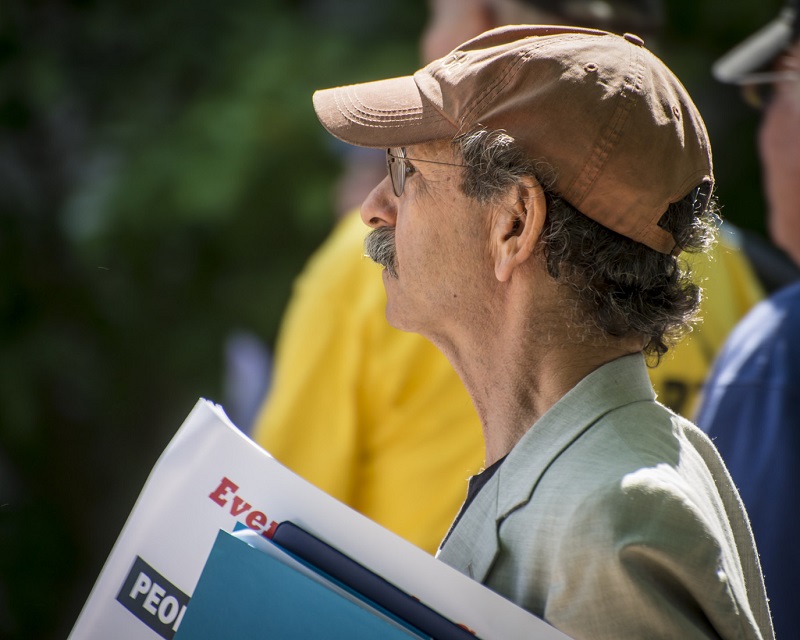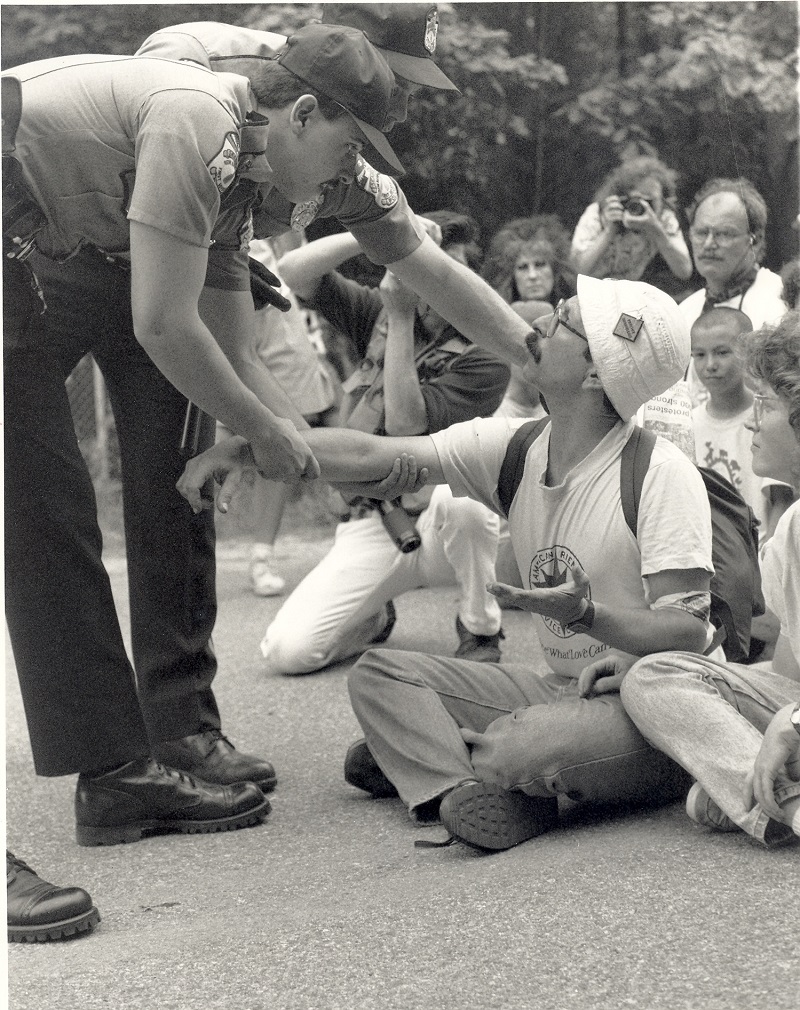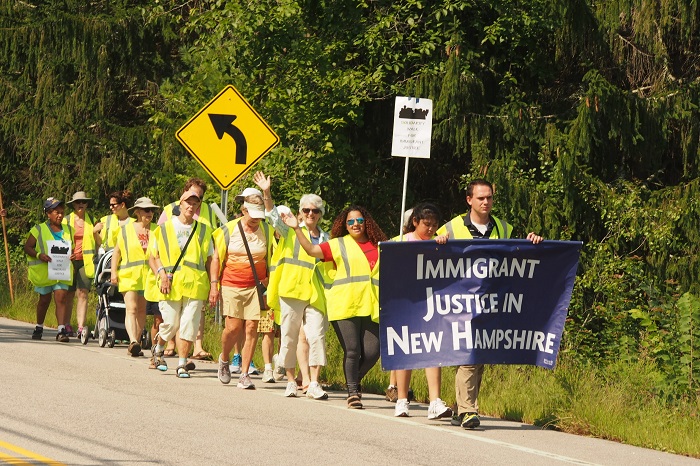
AFSC's Arnie Alpert. Becky Field / FieldWork Photos
Part 1 of an interview with Arnie Alpert, co-director of AFSC’s New Hampshire program
Since 1981, Arnie has coordinated AFSC's New Hampshire program. He’s a leader in movements for economic justice and affordable housing, civil and worker rights, peace and disarmament, abolition of the death penalty, and an end to racism and homophobia. This is the first part of a two-part interview, read part 2 here.
Sophia: How did you get started doing nonviolent direct action?
Arnie: During the time that I was in college I was very concerned about energy, environmental issues, and heard about demonstrations that were taking place in New Hampshire against construction against a nuclear power plant in a little town called Seabrook. It was through that that I had my first experiences with nonviolent training and then participated in a demonstration that involved some 2,000 people occupying the construction site for two days. On the second day, the police came in and arrested 1,414 people and took us away, and we were jailed for as long as two weeks. My very first trip to Concord, New Hampshire was when I was incarcerated in the National Guard armory here.
I’ve been involved in nonviolent direct action since then, in several ways. One is through organizing, and another is through training. I’ve been doing a lot of training and education about various ways of understanding nonviolence and nonviolent action, so for 40 years I’ve been doing that.
Since the Trump election and the rise of a more overtly violent movement against us, I’ve been doing a number of trainings. New Hampshire is a very gun-friendly state, and we started having people with guns showing up at Black Lives Matter demonstrations and pro-immigrant demonstrations. Looking at that, I realized we needed to give more attention to conflict de-escalation and to make sure that we had peace keepers to be able to help keep things in the frame that we want, so I’ve been doing quite a bit of peace keeper training, as well as during the Poor People’s Campaign doing a lot of nonviolent, moral fusion, direct action training.

Sophia: Can you tell me about the efficacy of nonviolent direct action and how your practice and philosophy of nonviolence developed?
Arnie: Some people think of nonviolence as being inaction or being about passivity. But what we’re talking about is how do we confront injustice, how do we confront violence, and how do we approach trying to bring about change. That starts out with a bias toward some type of action and then the question becomes what form of action do we want to engage in or to encourage.
Sophia: What would be your definition of nonviolent direct action because I agree with you, some people would confuse silence and taking a step back as not being violent, but a lot of the time that’s incredibly dangerous too, because you are actively perpetuating silence and excusing violence.
Arnie: When I do workshops, I spend a lot of time teasing out that question so that people can reach their own understanding of it rather than saying this is the definition, and this is what I mean by it.
I’ll often do an exercise where I’ll use a couple of different descriptions of nonviolence that have contrasts with each other and then I’ll ask people to tease out which of these understandings feels right to you, or how does this apply. So we can think of it as something very personal, how do I act, in terms of when I’m confronted with evil or injustice, or how do I act personally in order to bring about change.
We can also talk about how social movements operate and contrast nonviolent approaches to other than nonviolent approaches. We can also talk about direct action, I usually think that our actions themselves are what is transformative, rather than some other thing that we are helping to promote, and usually it’s in some way outside what we think of as conventional politics or outside the conventional way the system is supposed to operate. Voting is not violence, but voting is not nonviolent action. Working on an election campaign -- again it’s not violent, but it’s not nonviolent direct action. Going on strike is an example of non-violent direct action.
Sophia: What would you say to someone that thinks of nonviolence as civil or ineffective?
Arnie: Look at something like the anti-apartheid struggle in South Africa. If you look at what ultimately led to the downfall of apartheid you see largely that it was nonviolent methods: It was strikes, protests, boycotts, sanctions, and defiance campaigns that just made the apartheid system untenable, it made it collapse.
Look at Colin Kaepernick, that’s a great example of active nonviolence. Taking a very simple, nonviolent active protest in ways that have subjected him to considerable risk, and for which he suffered by losing his job. But again a tactic certainly had an effect; Black Lives Matter protests had an effect, and were a nonviolent form of action.

Sophia: Is there a story about a nonviolent direct action campaign that you worked on that you feel achieved its goals? Could you also tell me about a time when a campaign was ineffective?
Arnie: The campaign against the Seabrook nuclear plant led by the Clamshell organization is a good example. About 1,400 people were arrested in the action. The demonstration itself was huge and the fact that we were held in jail for two weeks meant that it generated a tremendous amount of public attention on the issue of nuclear power. It hadn’t received such attention before.
The people that were involved in that demonstration -- people from all over New England, the Northeast, and other parts of the United States, and some people from Europe -- used the technique of nonviolent direct action and civil disobedience as well as grassroots community education as ways to challenge nuclear power. Together all of these different efforts got enough attention to the risks of nuclear power plants that it started to affect the popular culture.
A couple weeks after release of a Hollywood film, “The China Syndrome,” depicting an accident at a fictional nuclear plant, there was an actual meltdown at the Three Mile Island nuclear power plant in central Pennsylvania. With that accident, the political opinion about nuclear power started to shift dramatically, support for nuclear power in Congress flipped, and notably, confidence in nuclear power on Wall Street took a nosedive. All of a sudden you’ve got the financial sector saying, “Gosh the power plants that we’re investing in could turn into a pile of radioactive rubble in a matter of seconds, maybe this isn’t such a good idea.” The nuclear power industry largely came to a halt in the United States, and I would attribute the growth of this grassroots nonviolent action oriented anti-nuclear movement to what made that possible, what made that happen.
For ineffective actions I would say that simply getting arrested without a clear goal. If people are basically saying what we need to do is civil disobedience because there’s something going on that’s bad and we want to protest it and civil disobedience is a way to resist, then that’s not likely to have much of an impact. If we start out that way, it seems to me that the big question is what can we do to get arrested -- as opposed to what are the dynamics we want to unleash that will have an impact on the injustice that we are trying to challenge. Simply blocking something or getting arrested doesn’t necessarily do anything.